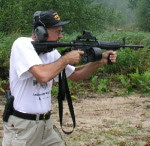The practice of press checking (or visually and physically checking to see if there is a round in the chamber) does not seem to be as widely used as it needs to be. This is an administrative procedure you should learn to do with your pistol.
I see many students during class whose first live fire experience results in a “click”. This is usually due to the fact that they have inserted a loaded magazine but forgot to rack the slide. Occasionally it is due to the magazine not being fully seated and a round is not stripped when the slide is racked.
The procedure I use when I pick up a gun that has been out of my sight is to first remove the magazine and make sure it is loaded and then fully seat it and tug on it to make sure. Then I partially retract the slide with my support hand (I use the overhand method but you can put your hand under the slide as well) and look to see if there is a round in the chamber and physically touch it with my trigger finger just in case it may be dark. Make sure you keep all parts of your hand away from the muzzle.
Some guns have a loaded chamber indicator but it is often difficult to see and I like to use the same manual of arms for all guns. Please ensure that the slide goes back into battery. The last thing I do is rub my fingers across the top of the slide to feel that the barrel has in fact locked up with the slide.
If you get into the habit of doing this whenever you holster your carry pistol you will always know it is ready to go if you need it.
